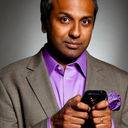Officially, Sree Sreenivasan is the dean of student affairs and a professor at Columbia University’s Journalism School, but for many he is the curator of Sree’s Tips, a Tumblr blog crammed with how-to social media information, as well as a leading figure in the social media movement. This past weekend he was also the point person for Columbia’s Social Media Weekend in New York.

What follows is a recap of some of Sreenivasan’s best advice for better utilizing Twitter from the weekend, as well as nuggets of information for doing better social media that were culled from the more than 50 speakers. When talking about social media, Sreenivasan tends to stress connections over self promotion (although being connected tends to lead to better promotion). He was also quick to stress throughout the weekend “We’re all learning here.”
Think Before You Tweet
Sreenivasan says he spends an average of three to five minutes thinking about and composing every tweet he sends out, which is a lot of time for a guy who pumps out half a dozen tweets on an average day.
It’s even more time considering that Sreenivasan concedes that “most people will miss most of what we send” through social networks. Still, Sreenivasan says what he tweets tend to have the biggest impact, and are therefore worth the extra care.
Content Is King
On Sunday, Sreenivasan pulled up his own Twitter page, which had tweets full of links, hash tags and mentions of other users. An @ mention insures at least one person will see your tweet, while links add value to the tweets you put out into the world.
“See all that blue?” he said, referring to the links. “All of those are connections or potential connections.”
Indeed, several presenters stressed the importance of not only including content, but presenting content in a way that encourages click-throughs. Erica Anderson, Twitter’s manager for news and journalism, said when sharing articles, try to find an interesting quote or tidbit from the story instead of simply tweeting the headline.
Anderson also said photos and video had also become more important since Twitter’s redesign late last year. In particular, they have become popular among reporters embedded with the presidential campaigns, who have been sharing candid moments. “People love photos on Twitter,” Anderson said.
Overhaul Your Twitter Profile
Sreenivasan pulled up the Twitter profile of New York Times reporter Brian Stelter and noted that he included two phone numbers, an email address, a Web site and a description of what he covered for the Times (as opposed to just saying he was a reporter for the paper).
Sreenivasan said that despite having more than 100,000 followers, Stelter has never received a prank phone call.
Stelter, who is as close to being a social media expert as one can get in journalism circles, also uses his full name on his profile. Users who just defer to their Twitter handle, a company name, or nick name risk not being found by people who want to follow them, Sreenivasan said.

Finally, Sreenivasan directed people to look past the number of people following Stelter and look at the 2,500 Stelter himself follows. That, Sreenivasan said, is the real value for using social media in journalism and other fields: by seeking out people to follow, we’re seeking more information, he said.
“Whatever you have as a number in that ‘following,’ space, it’s not enough,” Sreenivasan said.
Be Safe
Anderson spent a portion of her Saturday morning talk stressing security. She gave a plug for multi-platform manager 1Password and said people should get in the habit of checking their browser’s address bar for https:// as opposed to http:// before logging into Twitter and other sites.
Anderson also recommended using a company email account when signing up for Twitter and other sites where social interaction is encouraged. That can prevent hackers from accessing personal email accounts, which may have more sensitive personal information.
Keep Reading
One blog post is not enough to digest a weekend’s worth of info sessions. Some of the best tips have been curated under the hash tags #smwknd and #smwkndcool.










